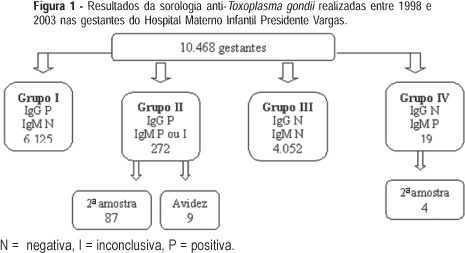Summary
Revista Brasileira de Ginecologia e Obstetrícia. 2006;28(3):158-164
DOI 10.1590/S0100-72032006000300004
PURPOSE: to describe and analyze the results of conventional serology for toxoplasmosis in pregnant women during prenatal care at the Hospital Materno-Infantil Presidente Vargas in Porto Alegre. METHODS: specific IgG and IgM determinations were performed using fluorometric tests, with IgM capture. A second sample within two to three weeks was requested from all IgM-positive pregnant women and IgG avidity was performed in IgM-positive pregnant women at the beginning of pregnancy. Neonatal IgM was obtained when the delivery occurred at the institution. The analysis was based on the binomial distribution, through simple ratio estimate, to assess soropositivity prevalence and susceptibility to T. gondi infection. RESULTS: the prevalence of infection in 10,468 pregnant women was 61.1% and 38.7% pregnant women were susceptible. Among the 272 IgG and IgM-positive pregnant women, 87 returned for a second test and in 84 of them the antibody levels remained unchanged. Of nine pregnant women with avidity, there was only one low avidity and her newborn was IgM positive. In 44 newborns delivered at the institution, the neonatal IgM was positive in four. CONCLUSIONS: a high prevalence of infection and congenital toxoplasmosis was found in pregnant women, even without data on seroconversion. Most of the IgM-positive serologies were related to past infection. The cost-benefit ratio of prenatal care in isolated samples may be optimized analyzing the risk of mother-to-child transmission in IgM-positive pregnant women. When there is a risk, a neonatal IgM test must be requested and the newborn should be followed during the first year of life.
